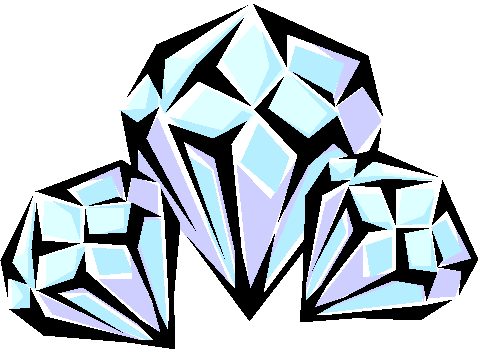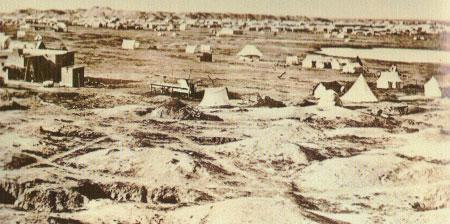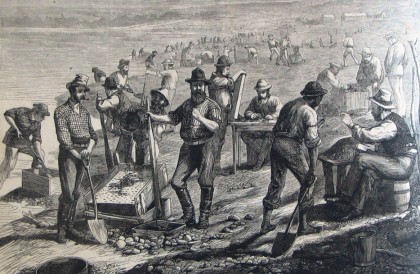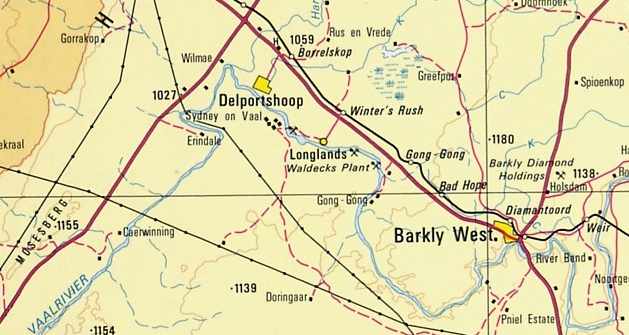
 Home
Page Back Ground History
Mining Regions
The Postcards
The Tokens
Links
Bibliography
Acknowledgements
Site
Forum Cards & Tokens Classified Ads.
Guest Book
Updates & News Contact
The Site
Home
Page Back Ground History
Mining Regions
The Postcards
The Tokens
Links
Bibliography
Acknowledgements
Site
Forum Cards & Tokens Classified Ads.
Guest Book
Updates & News Contact
The Site
 Home
Page Back Ground History
Mining Regions
The Postcards
The Tokens
Links
Bibliography
Acknowledgements
Site
Forum Cards & Tokens Classified Ads.
Guest Book
Updates & News Contact
The Site
Home
Page Back Ground History
Mining Regions
The Postcards
The Tokens
Links
Bibliography
Acknowledgements
Site
Forum Cards & Tokens Classified Ads.
Guest Book
Updates & News Contact
The Site

 Barkly West
& Vaal River Diggings
Barkly West
& Vaal River Diggings
Location: Northern Cape formerly Griqualand West (View location on map)
Minerals Worked: Diamonds (alluvial)
Principal Mines: Various diggings in and around Barkly West and the Vaal and Orange River valleys plus those of several of their tributaries.
Background History:
Barkly West, formerly known as Klip Drift, is located approximately 30 km north-west of Kimberly. The area started out as a diamond diggers town located on the North bank of the Vaal River, close to the small mission station at Pniel (founded 1849). The town's origins can be traced back to the start of diamond mining in South Africa in the late 1860s when this area of the country was still in a territorial "no mans land" between the British run Cape Colony and the Boer Republics of the Orange Free State and the Transvaal. The land was largely barren and the home to a mixed race tribe known as the Griquas.

An early mining camp on the Vaal River (c.1873)
The history of diamond mining in Griqualand West can be traced back to a Boer farmer, Daniel Jacobs, who worked the De Kalk farm at Hopetown on the south bank of the Orange River on what was then the northern border of the Cape Colony. The local river banks on the De Kalk farm were full of "coloured pebbles", the only playthings the Jacobs children had. These pebbles included carnelian, agates and many varieties of quartz and semi-precious stones. Among the pebbles which Erasmus, Jacobís young son, brought into the house one day in 1866 was a small white stone which sparkled in the sun. After changing hands several times this stone eventually was sent for identification to the leading mineralogist of the Cape Colony, Dr. W. Guybon Atherstone, at Grahamstown. It was so lightly valued that, to save postage costs, it was mailed to him in an unsealed envelope. Atherstone reported that the stone "is a veritable diamond, weighs twenty-one and a quarter carats, and is worth five hundred pounds. It has spoiled all the jewellers' files in Grahamstown, and where that came from there must be lots more." The stone, which later became better known as the "Eureka Diamond" was sold for £500 to Sir Richard Southey, the Governor of Cape Colony. It was subsequently sent to the Paris Exhibition of 1867 where it created interest, but no great sensation.
The news of the "Eureka" discovery set Boer farmers in the Orange and Vaal River Valleys to hunt for more diamonds. However, it was a further ten months before a second diamond was found, and this was on a spot thirty miles away, on the bank of the river below the junction of the Vaal and Orange rivers. In 1868 a few more small diamonds were picked up, and then, in March, 1869, a magnificent white diamond was picked up by a Griqua shepherd boy on the farm Zendfontein, near the Orange River. The new find was a superb white diamond of 85 carats and again eventually found its way to Sir Richard Southey, who proudly laid it on the table before the Cape Parliament, declaring, "Gentlemen, this is the rock on which the future of South Africa will be built". The diamond was appropriately named "Star of South Africa" and was eventually sold to the Earl of Dudley for £25,000.
The first-systematic digging for diamonds in the Vaal River Valley region commenced in November 1869. It was carried out by an organised party of prospectors from Maritzburg in Natal, initiated by Major Francis of the British Army, and led by Captain Rolleston. The systematic prospecting began at Hebron, where the party was joined by two experienced Australian gold diggers named Glenie and King, and also by a trader, named Stafford Parker, who, like the Australians, had already been attracted to the locality by the reports of diamonds descoveries. These prospectors shoveled the river gravel into "rokers" or "cradles" and practiced the techniques of placer washing which was then in vogue in America and Australia. They toiled for many days without sight of a diamond. They then followed the river twenty miles down to Klip Drift, opposite the Mission Station at Pniel. Here on 7th January 1870, they found their first diamond. More were to follow sparking of South Africa's first ever diamond rush. On 12th August 1870 the Grahamstown (Cape of Good Hope) Journal published the following entry;
"Every town and district in the Colony has sent its contingent to the army of workers at the Vaal fields. In May there were about one hundred men at the diggings. Before the end of June there were seven hundred, at the close of July there were over one thousand, and at present it is estimated that there are at the Klipdrift, Pniel, Hebron and Kuskamana Fields no less than two thousand men."
As soon as the news was published in London and New York, men began to flock from Britain and elsewhere to the new diamond diggings. Naturally much the larger number were from the colony's mother country. By April of 1871 there were about five thousand diggers scattered along the Vaal, Modder, and Orange rivers. They lived in tent communities in very harsh conditions being subject to blistering heat during the day followed by icy cold nights. Most of the diggers made little for their efforts although some made modest fortunes. The alluvia diamonds from the region were of a brilliant white quality. Their occurrence was not restricted to the immediate respective river banks but instead was spread right across the often thick gravel terraces that in areas spread for 3 or 4 miles either side of the rivers.
The hoards of in-coming prospectors had no sooner pitched their tents when a variety of individuals claimed ownership of the diamond field, and the right to levy rates and taxes. These claimants included the local Griqua chiefs plus both the Boer Republics of the Transvaal and Orange Free State. The ownership of the land was decided in favour of the local natives, the Griqaus who were the descendants of local tribes men and Boer trekkers who had earlier passed through the region. The diggers were not pleased with this decision and the British of the Cape Colony (to the South) persuaded the Griquas to sell the land to them. Once again the diggers were not pleased and on 30th July 1870 declared their own republic, the Klip Drift Republic, with Stafford Parker as its elected president. Parker ruled with a rough and ready justice and a miscreant could find himself being tarred and feathered, or pegged out in the sun for a day or two. Later that same year (1870) Sir Henry Barkly visited the diggings to restore order and administration and a high court for Griqauland. Give that most of the diggers originated from the Cape or Britain the Cape Colony authorities felt they has a vested interest to look after the interests of its citizens in the disputed region. This also gave the Colony an excuse to try and expand here authority and rule over this rapidly prospering diamond fields. As a result of Henry Barkly's visit to the diggers shantytown at Klip Drift it was re-named Barkly West and thereafter commenced a more sober career. In 1872, the British went on to annexed the diamond fields and soon after the Colony of Griqualand West was thus created. It was subsequently incorporated into the Cape Colony in 1880.
On arriving on the "diggings" newcomers might stake out a new claim (normally based on a 30 foot by 30 foot area) by taking out a license, or "jump" an old one if its former owner had not worked it within the previous 3 day period. At this time claims were sometimes changed hands for as much as £100 pounds, but not often. Claims located on the river were easier to work because of the close proximity to water. If the claim lay away from the river, the gravel had to be carted there for washing. If a digger required additional labour it was easily found through the employment of one or more of the local Griquas. The implements necessary for mining were few; a pick, shovel, rocker, or a couple of half barrels, and, if away from water, an ox or mule, and a cart. All of the latter could be hired by the day if the digger did not own them. Some diggers came fully equipped when they set off on their long trek to the diamond fields but equipment could often be obtained cheaper once at the diggings. Prior to the finding of the "Star of South Africa" the departures of diggers from the area was about as frequent as those of the new arrivals. The funds of many of the diggers were exhausted before they found anything, consequently there were enough implements being sold at auction all the time to supply all new comers.

Men at work on the Vaal River Diggings (1870)
The principle tool used by the diggers to processing the alluvia deposits was a crude screening device known as a "rocker" or "cradle" (see image above). It consisted of a box about 2.5 feet high, open at the top and one end which rested on rockers like a cradle. In the top of the rocker were set 2 or 3 screens decks arranged in vertical decks one above the other. Each screen was made of wire or perforated zinc. The decks each had progressively smaller apertures in them, coarse, medium and fine; the coarsest one on top. A piece of wood, nailed perpendicularly to the closed end of the box, served as a handle so that the digger could stand in front and rock it. The earth and gravel was shoveled into the top screen and one digger rocked while another poured in water. When the screens were full of stones, caught as the water washed the dirt through them, the retained stones were emptied onto a sorting table, where the digger with a piece of zinc several inches long and straight on one edge, scraped off the worthless stones, saving only those of value. Generally the table was scraped clean. Some diggers used two tubs for washing or a barrel cut into two halves which were filled with water. A square sieve was filled with gravel and shaken in the first tub until the dirt and fine gravel was washed out. The stones were then rinsed in the second tub and emptied on the sorting table.
The majority of the prospectors abandoned the various Vaal River diggings when the richer diamond deposits of nearby Kimberley were discovered in the early 1870s. However, the Vaal River gravels close to Barkly West continued to yield diamonds for many years afterwards (as they still do today) sparking minor diamond rushes back into the area. One such secondary diamond rush occurred in 1922 on Mosesberg Farm, situated up river from Barkly West close to a place by the name of Sydney-on-Vaal. Diamonds were discovered on this farm in 1921. This triggered a rush of about 2,000 diggers into the area who staked their claims in the hope of making quick fortunes. Unfortunately most of these new claims soon proved to be barren and those where diamonds were found rapidly became worked out. Consequently most of the diggers moved on when news came of the newly discovered alluvial diamond deposits at Lichtenburg in the Transvaal in 1923.

Barkly West & the part of the Vaal River Diggings (Mosesberg Farm area on bottom left)
Today many unexpected waterfalls, pools and breakwaters bear witness to the diamond rushes in the area around Barkly West, and some have even become a part of local folklore. One pool below Kimberley Bridge is called Beaumontís Folly for it was here in 1898 that George Beaumont assembled and floated a large dredger to haul diamonds from the bottom of the Vaal only to be defeated by the uneven surface of the river bed.
The Tokens
The Postcards
Postcard issues relating to these "wet diggings" include the following.
| "Thumbnail" Images (Note 1) | Card Title or Description | Card Ref. No. |
| Barkley West & Vaal River Diggings (General) | ||
| Typical Diggers' Tent (Bergstrom) on the Vaal River, Barkly West | PC99 | |
| Diamond Digging near Kimberley - Typical River Digger's-claim. | PC100 | |
| Diamond Diggers after a day's work | PC101 | |
| "Typical South Africa". Diamond Diggers after a day's work | PC119 | |
| The Diamond Rush to the Vaal River. Sorting. | PC160 | |
|
The Diamond Rush to the Vaal River Diggings. Diggers (New Arrivals). |
PC172 | |
| Diamond Digging | PC176 | |
| Mosesberg Diggings | ||
| Mosesberg Diggings June 1922 | PC120 | |
| Mosesberg Diggings (Dentre???) June 1922 | PC121 | |
| Mosesberg Diggings June 1922 | PC122 | |
| Mosesberg Diggings June 1922 | PC123 | |
| Mosesberg Diggings June 1922. Offices & Stores | PC124 | |
Notes:
1) For further information and enlarged views of each postcard click on any one of the above images.